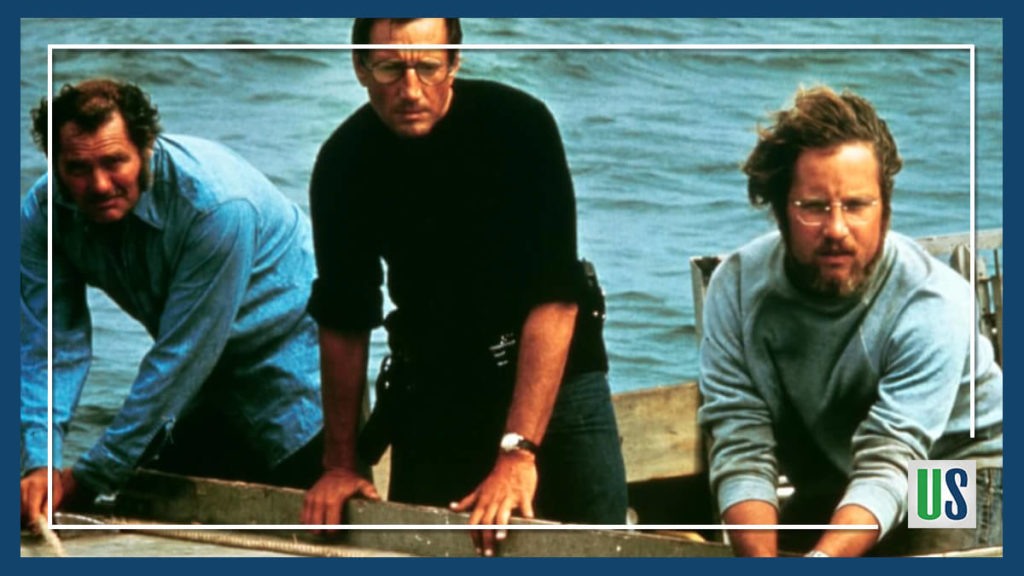What is the first thing that comes to mind when thinking of Jaws? Here’s mine: Duunnn dunnn… duuuunnnn duun… duuunnnnnnnn dun dun dun dun dun dun dun dun dun dun dunnnnnnnnnnn dunnnn.
45 years ago, Jaws hit theaters, and little did it know, it would change the film industry forever. There’s a case to be made that in terms of blockbusters, Jaws is the defining blockbuster of the modern era. There are films before it and after. Let’s start with the film itself. In layman’s terms, Jaws is about three dudes (Roy Scheider, Richard Dreyfuss, and Robert Shaw) who hunt down a killer great white shark that’s been terrorizing a local beach town. Except it’s so much more than that. It’s an edge-of-your-seat thriller that requires a Xanax after the end credits. A killer, man-eating shark makes it a horror, but Jaws also highlights masculinity and the power struggle between men. The political decisions in Jaws mirror the political choices during the coronavirus pandemic as local governments battle unruly residents on how to reopen the economy. Should we listen to the experts or hit the beaches for the Fourth of July?
Jaws is a masterclass in how to create suspense without revealing your villain too early. It’s fucking terrifying especially the first time you see it. Think about this. The shark doesn’t fully appear onscreen for one hour and 21 minutes into the film. A lot of that had to do with mechanical problems with the shark so director Steven Spielberg had to find ways to shoot around these deficiencies. The anticipation and ominous presence only heighten because of John Williams’ Academy Award-winning score.
I can’t believe it’s taken me this long to talk about Spielberg. At the time of its release, Spielberg was an unknown 27-year-old kid with little studio experience. Part of what makes Jaws so legendary is the behind-the-scenes drama. There are so many documentaries about how the production of Jaws was like hell on earth. The shoot was supposed to last 55 days, but it ended up being 159 days. With mechanical shark malfunctions, a budget that ballooned from $4 million to $9 million, and onset drama between Dreyfuss and Shaw, Spielberg believed Jaws would be the end of his career.
Well, Mr. Spielberg, Jaws did not ruin your career. In fact, Jaws turned Spielberg from an unknown to a superstar in one summer. “Jawsmania” was a real thing during the summer of 1975. Jaws made over $490 million at the box office, which was a record at the time until Star Wars passed it two years later. My parents, who both saw the film in theaters, talked about how people were afraid to go into the ocean that entire summer. Speaking from experience, before I dive into the water, I check the horizon to see if a shark fin is on the horizon. I can thank Jaws for that.
More importantly, Jaws set the precedent for summer blockbusters. Up until then, studios would release films of lesser quality in the summer because they were of the thought that only teenagers went to the movies during those months. Winter was seen as a more profitable month for big studio releases. However, Jaws made the summer the most important time for blockbusters. Jaws spent more than $2 million on marketing in the lead up to the release. Network television spots created a sense of familiarity with audiences because they knew the premise and heard William’s suspenseful score before going to theaters. Plus, Jaws opened in over 400 theaters on the first weekend, which was unheard of at the time. Spending huge money on marketing and opening in hundreds of theaters is the blueprint that studios still follow to this day.
Despite poorly-received sequels, Jaws has still survived the test of time. It was selected by the Library of Congress I’ve rewatched parts from Jaws dozens of times and the fear in the pit of my stomach still remains as if it’s my first viewing experience. No matter what happens, always remember that Hooper drives the boat, chief.
Will you watch this classic on the 45th anniversary? Leave your thoughts in the comments below or tweet us, @unafraidshow.
